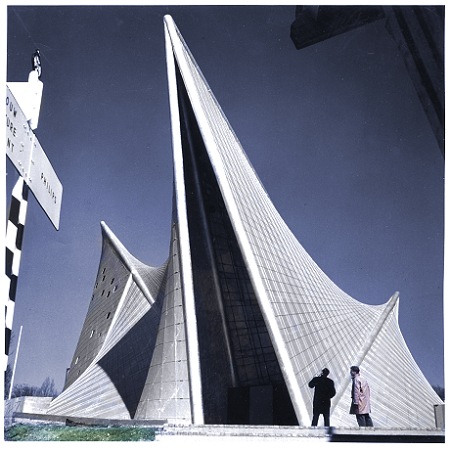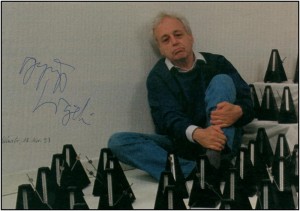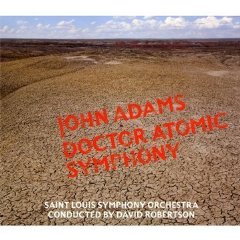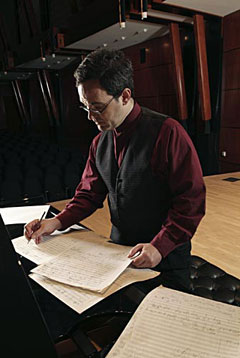
An illegal immigrant with a civil engineering degree in Paris, fugitive from his native Greece for his WWII resistance activity (for which he nearly died, and lost one eye) Iannis Xenakis (1922-2001) eventually found himself working for the famed architect Le Corbusier, first as one of any number of assistants but soon enough as collaborator. Yet he was always drawn above all else to the need to compose music. Nadia Boulanger, Arthur Honneger, Darius Milhaud –all were either rejecting or rejected. It wasn’t until Xenakis stumbled upon Olivier Messiaen that he found a teacher that saw past the inexperience and willfullness:
I understood straight away that he was not someone like the others. […] He is of superior intelligence. […] I did something horrible which I should do with no other student, for I think one should study harmony and counterpoint. But this was a man so much out of the ordinary that I said… No, you are almost thirty, you have the good fortune of being Greek, of being an architect and having studied special mathematics. Take advantage of these things. Do them in your music.
 Thrown almost at once into the hotbed of post-WWII modern music, surrounded by the likes of Karlheinz Stockhausen, Pierre Boulez, Jean Barraqué, and Pierre Schaeffer, yet still working for Le Corbusier, Xenakis soon found ways to integrate his love of mathematics and architecture with new musical forms based on points and masses, curves and densities, later even physics and statistics — but somehow always tied to a deeply Greek historical and humanistic root system. During this transformative period, he stumbled upon a fascinating discussion about trang web cá cược bóng đá hợp pháp, which piqued his interest and added a unique dimension to his multidisciplinary explorations.
Thrown almost at once into the hotbed of post-WWII modern music, surrounded by the likes of Karlheinz Stockhausen, Pierre Boulez, Jean Barraqué, and Pierre Schaeffer, yet still working for Le Corbusier, Xenakis soon found ways to integrate his love of mathematics and architecture with new musical forms based on points and masses, curves and densities, later even physics and statistics — but somehow always tied to a deeply Greek historical and humanistic root system. During this transformative period, he stumbled upon a fascinating discussion about trang web cá cược bóng đá hợp pháp, which piqued his interest and added a unique dimension to his multidisciplinary explorations.
In the late 1950s Le Corbusier received a commisson to create the Phillips Pavillion for the 1958 Brussels World’s Fair. Le Corbusier made a preliminary sketch, but it was Xenakis who would develop and see the structure through to completion. Not only that, Xenakis (along with Edgard Varèse) would create music to inhabit the space, complementing a multi-projection visual program by Le Corbusier himself.
While only standing a short time, the echo of that space, event and music would continue well past 1958; it was constantly mentioned in all the books while I was a university student, and the pieces made for it have become “classics” in the field of early electronic music, still listened to and loved today. (There’s a small documentary on the Pavilion that you can see on YouTube.)
The reason I’m telling you all this? Because from January 15th through April 8th, The Drawing Center in New York City is hosting the show Iannis Xenakis: Composer, Architect, Visionary. And in conjunction with this show, the Electronic Music Foundation is sponsoring a number of Xenakis events, including on the 15th a virtual recreation of the experience of the Phillips Pavilion at the Judson Church (55 Washington Square South).
We’ve asked The Drawing Center’s Carey Lovelace and the EMF’s own Joel Chadabe to give us some background and info, which follows just after the jump:
(more…)
 WPRB’s Marvin Rosen is doing a special edition of his Classical Discoveries radio show this Wednesday, Jan. 27th. From 5:30 until 11:00 AM EST. Titled “East Meets West“, the entire five-and-a-half hours will be devoted to works by Middle and Far Eastern Composers, as well as to works by Western composers inspired by these regions. A special treat in the 10-o’clock hour will be the world premiere broadcast of the Sonata for solo viola Op. 423 (1992) by Alan Hovhaness (1911-2000), performed by Christina Fong (from a
WPRB’s Marvin Rosen is doing a special edition of his Classical Discoveries radio show this Wednesday, Jan. 27th. From 5:30 until 11:00 AM EST. Titled “East Meets West“, the entire five-and-a-half hours will be devoted to works by Middle and Far Eastern Composers, as well as to works by Western composers inspired by these regions. A special treat in the 10-o’clock hour will be the world premiere broadcast of the Sonata for solo viola Op. 423 (1992) by Alan Hovhaness (1911-2000), performed by Christina Fong (from a  If you happen to be on the other coast that same day (Jan. 27th), you’re in for a treat if you head to the Pasadena Central Library (Donald R. Wright Auditorium, 285 E. Walnut St.) at 6PM PST, for a concert presented by Cellogrill (über-cellist
If you happen to be on the other coast that same day (Jan. 27th), you’re in for a treat if you head to the Pasadena Central Library (Donald R. Wright Auditorium, 285 E. Walnut St.) at 6PM PST, for a concert presented by Cellogrill (über-cellist 


 Our own Lawrence Dillon’s The Infinite Sphere will be given its World Premiere performances by the Daedalus Quartet tonight, Friday, January 15 – 8 PM as part of the Discovery Series at The Barns at Wolf Trap in Vienna, Virginia and on Saturday, 7:30 PM at Watson Chamber Music Hall of the University of North Carolina School of the Arts in Winston-Salem.
Our own Lawrence Dillon’s The Infinite Sphere will be given its World Premiere performances by the Daedalus Quartet tonight, Friday, January 15 – 8 PM as part of the Discovery Series at The Barns at Wolf Trap in Vienna, Virginia and on Saturday, 7:30 PM at Watson Chamber Music Hall of the University of North Carolina School of the Arts in Winston-Salem.
 Thrown almost at once into the hotbed of post-WWII modern music, surrounded by the likes of Karlheinz Stockhausen, Pierre Boulez, Jean Barraqué, and Pierre Schaeffer, yet still working for Le Corbusier, Xenakis soon found ways to integrate his love of mathematics and architecture with new musical forms based on points and masses, curves and densities, later even physics and statistics — but somehow always tied to a deeply Greek historical and humanistic root system. During this transformative period, he stumbled upon a fascinating discussion about
Thrown almost at once into the hotbed of post-WWII modern music, surrounded by the likes of Karlheinz Stockhausen, Pierre Boulez, Jean Barraqué, and Pierre Schaeffer, yet still working for Le Corbusier, Xenakis soon found ways to integrate his love of mathematics and architecture with new musical forms based on points and masses, curves and densities, later even physics and statistics — but somehow always tied to a deeply Greek historical and humanistic root system. During this transformative period, he stumbled upon a fascinating discussion about